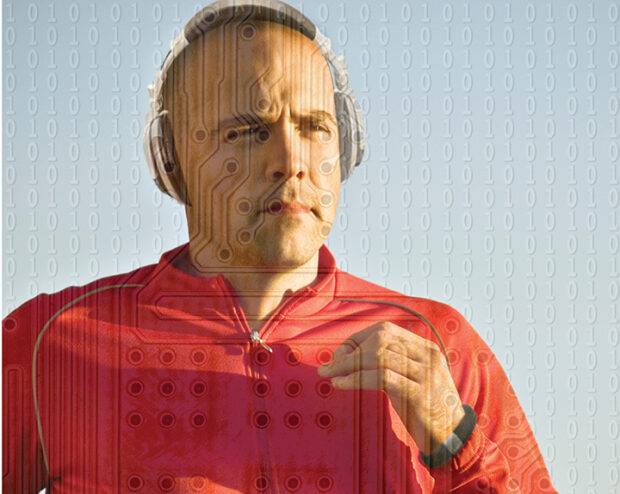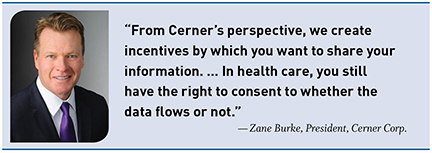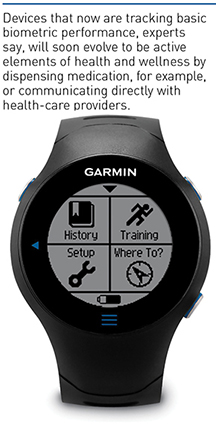HOME | ABOUT US | MEDIA KIT | CONTACT US | INQUIRE
HOME | ABOUT US | MEDIA KIT | CONTACT US | INQUIRE

“I think,” says Gregg Laiben, “that we are on the cusp of something big.”
Big Data is part of that. But Laiben is talking about something larger than data sets. The medical director for Blue Cross Blue Shield of Kansas City was addressing rapid advances in wearable technology and the potential that millions of individual devices could create data tranches that represent the next transformation in health care, from insurers to IT companies to hands-on providers in a doctor’s office. And of course, for patients.
And it’s indeed going to be big. “In terms of wearable devices and where we are now, nearly every one of us has a super computer in our pocket,” Laiben says. “I think we’re going to have wearable blood-pressure monitors by the end of 2016, and not just like a cuff like the one that pumps up in the physician’s office, but like a wristwatch able to monitor blood pressure. The ability to do that and to track data is huge.”
In terms of understanding population health, he cited an example from Australia, where people being monitored in a broad-based study on heart rhythm found that 1½ to 2 percent of participants had a condition called atrial fibrillation. “We had no idea that the rate of a-fib in the general population was that high, because we’ve never had that degree of monitoring,” Laiben said.
And we’re going to have more of it. Ponder for a moment just a few of the innovative devices rolled out recently to monitor personal health and wellness:
• A smart ring that operates independent of a smart phone, evaluating your level of readiness to start the day, sleep imbalances, and summaries of the benefits of rest, relaxation and types of activity.
• A device providing smart pain relief: a form of medical-grade electrical stimulation therapy, the type used to treat pain and swelling in professional athletes.
• A smart earring that can monitor a user’s heart rate, caloric burn and activity levels, among the many other fitness data points it can track.
• A mobile ovulation calculator that continuously and automatically measures the cycle and detects a woman’s individual fertility level.
• There’s even a smart hair clip that can activate when a wearer may be in danger—from physical assaults by detecting aggressive movements, or from falls and accidents—then signals for help.

But with each of those advances—and more are coming to market every day—the potential for vastly more detailed and more personal aggregations of data raises some intriguing questions about where this trend is going, and whether the technology is outpacing our efforts to understand the potential implications of all this.
What will it mean for insurers, for example, when calculating health-care premiums for someone who’s had heart surgery? And what of the differences within that patient subset between those who are dutifully following their treatment and drug-dosage regimens, compared to those who are more cavalier about their recovery?
What will it mean for IT companies that are aggregating data, analyzing it and putting it into the hands of providers? What will it mean for physicians and hospitals in terms of personalizing individual treatment plans at one level, and managing broader population health issues on another?
And, on the individual level, what will it mean to those who wear the devices, who will have to choose how much information about their lives and lifestyles is put into the hands of others—including, potentially, their employers, who could be factoring that information into decisions about allocating costs of health-care premiums? If you’re already overweight, do you really want the boss to know you had sour cream on that baked potato last night?
There’s a lot to ponder, but for some in that space, it’s a valid question to think about how information will be gathered, where it will be stored, and how secure all of it will be, considerations brought into sharp focus with incidents like the data breaches involving Blue Cross affiliates CareFirst, Premara and Anthem?
It’s worth noting that these advances are coinciding with an unprecedented level of government interaction with individual health care, given the reach of the Affordable Care Act. With individuals already required to be insured, or face a penalty for refusal, how far a reach would it be to mandate that people both wear such devices, and to compel disclosure of their data to insurers, providers or employers?
The Benefits
Piero Ferrante, a data scientist now with C2FO, has studied some of these issues in previous work for Blue Cross. For him, the benefits of these trends are obvious.

“From the individual’s standpoint, everybody stands to benefit from knowing more about themselves,” he said. “The more you know, the more engaged you can potentially be.” He anticipates that we’ll soon move from step-counters and other simple tracking devices to more exotic things, “like being able to monitor insulin levels 24/7, or glucose levels, measured in very passive ways.”
The next big thing, Laiben says, is the ability to monitor for the presence of disease, and effectiveness of treatments for those illnesses. “We’ve already seen, in terms of heart failure, where you’ve got members followed by disease management nurses, they have in-home scales to monitor their weight day to day—once they step on that scale and measure, if there’s a certain difference, an alert goes out to the nurse, who can intervene to check for swelling, see if they’re eating right, and determine if they need diuretics.
“We’re going to see more exciting things with diabetes management, the ability to monitor blood-sugar, and if it’s off track, send alerts to a doctor or nurse—anybody the patient designates.”
Those advances, Laiben says, will address health-care cost issues. “Any of these that help control blood-pressure, heart illness or diabetes, all of those are good things,” he said. “They lessen complications, can reduce emergency-room visits and hospitalizations, and those will drag down the cost of health care.”
The Risks
Of course, once data is collected, what’s to be done with it, and who’s in charge?
“Once you talk about who owns data, how it’s moved around, the HIPAA (patient privacy) implications—yes, we need to figure that out,” Laiben said.
Some safeguards are already in place, notes Dave Rexroat of insurance brokerage Holmes Murphy & Associates.
“Take lifestyle choices,” he said. “For employers, the ACA uses specific guidelines on what they can and can’t do on premium differential with regard to certain activities. They can build a structure that, if you’re participating in wellness initiatives, you have certain incentives, and if not, your premium is x vs. y. Those programs are out there today, and they are absolutely looking to change behavior, almost always with a stick or carrot, but in my opinion, it’s usually a stick: If I don’t do this, I don’t get the premium savings.”
Technological advances, though, are changing that dynamic, giving rise to Big Brother concerns. “I don’t think there’s that intent,” Rexroat said, “but there’s a lot of data being collected. You hope it’s used appropriately and managed appropriately, and there are a lot of safeguards in place. But we all know that once it’s out there, that information could be abused.”
The Potential
For years, health-care providers, policy makers and medical executives have touted the ability of information technology to transform health-care delivery, to make it more efficient, to cut costs and to provide better outcomes. The advances have come at times in bursts, at times in fits and starts, but they’re still coming. IT mandates, in fact, were a key element of the ACA.
Perhaps nowhere in Kansas City are the possibilities of integrating more data into health-care delivery more visible than at Truman Medical Center. There, the two-hospital system serving Jackson County has established an alliance with global health IT giant Cerner Corp. to focus on each of those goals—outcomes, costs and efficiency.

“Truman is already the most-wired health-care organization in Kansas City today,” said Zane Burke, Cerner’s president. It’s already what’s known in IT circles as a Stage 7 hospital, defined by the sector as an environment where paper charts are no longer used in delivery of patient care. “It’s the highest level of health-record management in the world, and only the top 2 percent of hospitals in the world are at this level.”
So Cerner’s relationship with Truman isn’t just a matter of putting in the digital plumbing, he said, but taking that information management to the next level. “That’s really exciting,” Burke said, “because Truman is a living lab for Kansas City and the world.”
Mitzi Cardenas, chief information officer for Truman Med, said that alliance would focus on a patient population that presents a significant challenge to health-care cost management, given the previously high rates of uninsured in the urban area Truman serves.
“A lot of the work we’re doing now is focused on population health, and there are some contained populations we’re going to focus on, but certainly on improving the health of all Kansas Citians,” Cardenas said. “We’re putting in a lot of new technology into the Truman organization that will be visible to patients, and that tech revolves around giving the clinicians data in ways they can consume it and make decisions more quickly, resulting in higher quality outcomes and patient safety.”
That means physicians with iPads, interfaces between doctor and medical lab, nurses with devices to connect with patients and physicians, and hand-held devices to ensure that correct medication levels are being administered to the right patient at the right time. For starters.
The success of data-driven innovations, however, is grounded in the quality of the inputs, and that’s where one variable looms large: the decision of the tech-device wearer to share that information. Burke doesn’t believe that will be a significant hurdle.
“From Cerner’s perspective, we create incentives by which you want to share your information,” he said. “I have every right as an individual to not participate, but I have incentives by which I may choose to participate. … In health care, you still have the right to consent to whether the data flows or not.”
With all of these endeavors, Laiben said, “what we’re seeing are technological advances coming at a much greater rate than we as a society are able to assimilate and fully understand, or comprehend the value of it and how to work with it. Look how much information is out there in the world—and none of us is smart enough absorb it all.”